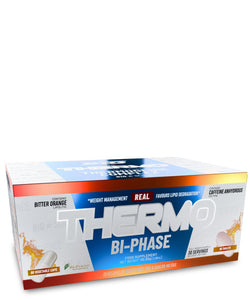
Dry as a raisin
Sergio Guerrero
INTRODUCTION
In this new entry and taking advantage of the good weather, we will talk about the Real Thermo . A supplement formulated by Adrián Díaz Rúa and Carlos Mejías to help fat oxidation during a definition stage.
Emphasize that it is only a supplement, that it does not work miracles, and whose basis must always be a good diet, exercise and physical activity pattern, in order to generate a caloric deficit.
On the BIG® Website we are presented with the Real Thermo supplement, whose formulation is very innovative, since it is biphasic, that is, it comes in sustained release tablets and quick release capsules. The prolonged-release tablets will exert their effects during everyday life, in daily tasks, work, etc., while the quick-release capsules will do so in the moments before practicing sports.
Among the compounds that are part of Real Thermo we find the following:
- anhydrous caffeine
- Green Tea dry extract with an EGCG (epigallocatechin gallate) content of 50% and 2% caffeine naturally present in Green Tea
- Bitter orange dry extract with a content of 6% p-synephrine
- Dry extract of black pepper standardized to 95%

- Figure 1: 2 capsules (left image) and 2 tablets (right image) form 1 Dose.
MECHANISM OF ACTION
Caffeine
Well, we have already seen a lot about caffeine in previous articles, but to refresh a little we will say that when you ingest caffeine, it reaches the brain through the bloodstream. There, it mimics adenosine, a compound that is present throughout the body.
Adenosine functions as a central nervous system (CNS ) depressant. Caffeine “imitates” adenosine by binding to its receptors and causing stimulation, in addition to the release of catecholamines: dopamine, norepinephrine, glutamate and adrenaline (Fig. 2). These catecholamines are secreted in the adrenal glands and prepare the body for imminent danger; your heart rate accelerates, your focus of attention is greater, etc.

- Figure 2: Mechanism of action of caffeine.
Well, since we already know how caffeine works, what function does it have when it comes to oxidizing fats?
Caffeine influences energy balance by increasing energy expenditure and decreasing energy intake , therefore, it is potentially useful as a regulator of body weight. Caffeine improves weight maintenance through thermogenesis, fat oxidation, and energy intake .
The sympathetic nervous system is involved in the regulation of energy balance and lipolysis (breakdown of lipids into glycerol and free fatty acids) and the sympathetic innervation of white adipose tissue may play an important role in the regulation of total body fat.
Caffeine is rapidly absorbed through the gastrointestinal (GI) tract and moves across cell membranes with the same efficiency as when it is absorbed and circulated to tissues. Caffeine is metabolized in the liver and, through enzymatic action, produces three metabolites: paraxanthine, theophylline, and theobromine .
Elevated levels of caffeine appear in the bloodstream at around 15 to 45, and peak around 60 minutes, while its half-life is around 4-6 hours , depending on dose and interference. with certain foods and gastric emptying. As a lipid-soluble compound, caffeine freely crosses the blood-brain barrier and therefore affects neuronal function.
Caffeine increases the excitability of the sympathetic nervous system (SNS). The SNS is considered an essential component of the autonomic nervous system and plays an important role in maintaining energy homeostasis through hormonal and neural control . The SNS has been described as a complex regulatory system involving direct effects of the sympathetic nerves that innervate most body tissues, as well as indirect effects through catecholamines, epinephrine, and, to a lesser extent, norepinephrine. SNS activation has been shown to suppress hunger, increase satiety, and stimulate EE, in part by increasing fat oxidation .
The intracellular signal, which produces increased lipolysis, heat production in skeletal muscle, and putative satiety signals in the liver, depends on the production and presence of cyclic adenosine monophosphate (cAMP). The increased cAMP response is short-lived as it is rapidly degraded by phosphodiesterase (PDE). These actions promote lipolysis through the activation of hormone-sensitive lipases with the release of free fatty acids and glycerol. The greater availability of these fuels (fatty acids and glycerol) in skeletal muscle acts by saving muscle glycogen consumption. All this seems very difficult to understand, but surely with figure 3, you can see it better.

- Figure 3: Role of caffeine in thermogenesis and energy intake.
Green tea extract: EGCG (epigallocatechin gallate).
Green tea, along with black and oolong tea, comes from the Camellia sinensis tea plant. Green tea, unlike black tea and oolong tea, is not fermented, so the active components of the herb are not altered .
The main catechins in green tea are epicatechin, epicatechin-3-gallate, epigallocatechin and, the highest concentration, epigallocatechin-3-gallate or EGCG . These catechins inhibit an enzyme called catechol-O-methyltransferase, or COMT, which actually breaks down the body's main “fat-burning” hormone, norepinephrine. The function of catechins, especially EGCG, helps to raise norepinephrine levels, keep them elevated and prolong thermogenesis (Fig. 4) .

- Figure 4: Overview of short- and long-term mechanisms of green tea.
Regarding its pharmacokinetics, it has been investigated in humans in several studies that administer purified EGCG, tea or green tea extract, whose absorption after oral administration varies between 1 to 5 hours, reaching its maximum peak between 1-2 h. post intake. The elimination half-life of EGCG takes place around 3 hours .

- Figure 5: Metabolic and vascular functions of EGCG. A schematic diagram showing the mechanisms for AMPK activation by EGCG. AMPK is a key molecule that regulates enzymes involved in energy metabolism and endothelial functions.
To do this, black pepper extract has been added to the compound, where piperine has been shown to inhibit its glucuronidation in the small intestine, as well as inhibit gastric emptying and gastrointestinal transit, which can result in greater absorption.

- Figure 6: Factors influencing EGCG bioavailability: Factors that increase plasma EGCG levels are listed on the left, those that decrease bioavailability can be found on the right. Most of these factors are easily modifiable.
As a recommendation, it seems to be appropriate to take an oral dose in the morning after a period of overnight fasting, at least 30 minutes before breakfast, and a second dose about 30 minutes before training and whose last intake was approximately 4 hours, to reach high plasma levels of EGCG .
Bitter Orange Extract: P-Synephrine
Synephrine, also known as p-synephrine or oxedrine, is a natural alkaloid (phenethylamine alkaloid) present in extracts of bitter orange (also called Seville orange, sour orange or Citrus aurantium L.) and other citrus species, which It is widely used for weight loss or weight loss, sports performance, appetite control, energy and mental focus and cognition. Bitter orange extracts contain p-synephrine which comprises about 90% or more of the total protoalkaloids.
Questions have been raised regarding the safety of p-synephrine because it has some structural similarity to ephedrine (Fig. 7) (the main component of the herb ephedra). p-synephrine is widely known as a stimulant and is assumed to exhibit cardiovascular activity due to its structural similarity to ephedrine . However, chemical differences between p-synephrine and ephedrine greatly alter stereochemistry, pharmacokinetics, adrenergic receptor binding, and physiological/pharmacological properties. Therefore , the effects observed with ephedrine cannot be extrapolated to p-synephrine and bitter orange extracts .
The U.S. Food and Drug Administration (FDA) banned the use of ephedra in dietary supplements because it increases blood pressure and is linked to heart attacks and strokes. P-synephrine became popular as an active ingredient for thermogenics and weight loss supplements due to the ban of ephedra species by the US Food and Drug Administration in 2004.
Fortunately, the "synephrine" they were referring to in those studies was m-synephrine (Fig. 8), a popular over-the-counter nasal decongestant also known as phenylephrine. This, unlike p-synephrine, is not a naturally occurring alkaloid found in Citrus aurantium (bitter orange extract).
Currently, the WADA (World Anti-Doping Agency) has it on the monitoring list, along with caffeine, among other substances).

- Figure 7: Structures of synephrine (p‐synephrine) and ephedrine.
Regarding its pharmacokinetics , the half-life of p-synephrine is 2 to 3 hours . In the past, it was speculated in the literature that p-synephrine could be converted to octopamine* in vivo, although studies in humans have not revealed any conversion. Similarly, it is conceivable that p-synephrine could be converted to epinephrine by enzymes located in the liver, although there has been no direct evidence that this actually occurs.
*Octopamine: endogenous biogenic amine related to norepinephrine, and which has effects on the adrenergic and dopaminergic systems.

- Figure 8: Chemical structures of p-synephrine and m-synephrine.
The mechanisms suggested with the use of p-synephrine to improve thermogenesis and fat oxidation at rest and during exercise are due to its ability to bind to β-3 adrenoceptors. β-3 adrenergic receptors are expressed in human white and brown adipose tissue, as well as skeletal muscle, and play a role in regulating energy balance and glucose and fat homeostasis .

- Figure 9: Physiological effects of p-synephrine through its binding to β-3 receptors
DOSAGE AND SIDE EFFECTS
Caffeine
As we already know, moderate-high doses of caffeine, between 3-9 mg/kg, increase sports performance . Regarding the use of fats as an energy substrate, the work of Ruiz Moreno et al, 2021, demonstrated that the intake of 3 mg/kg increases the maximum fat oxidation (MFO) during a weight training exercise. resistance at the point of maximum fat oxidation (Fatmax). In this same trial, in addition to greater fat oxidation, a reduction in carbohydrate oxidation and a decrease in perceived fatigue measured with the Borg scale (Fig. 10) was observed.

- Figure 10: Fat oxidation rate with a dose of 3 mg/kg.
Numerous studies described the beneficial effect of caffeine on energy expenditure. Leblanc et al. In 1985, they conducted a study on eight trained and eight untrained young men. Both groups were instructed to consume a cup of coffee containing 4 mg/kg caffeine after an overnight fast, which resulted in increased resting energy expenditure (RMR) values in both groups. groups, but a greater increase in RMR in the trained subjects. This effect was also associated with a greater increase in plasma free fatty acids and a greater drop in respiratory quotient, indicating greater lipid oxidation following caffeine consumption in trained subjects. Another study, this one by Poehlmann et al., 1985, studied 14 trained and 10 untrained men. Subjects were supplemented with 300 mg of caffeine after an overnight fast, which led to an increase in RMR in both groups, but in contrast to the results of Leblanc et al., 1985 a greater increase was observed in subjects untrained. It is not clear why the two studies produced contradictory results. One possible explanation may be related to the protocols of the two studies, which were not conducted with a double-blind design and did not use a placebo. Furthermore, Leblanc et al. used coffee and Poehlman et al. used pure caffeine. Caffeine is more potent when consumed in an anhydrous state (capsule/tablet/powder), compared to brewed coffee.
Another of the great enigmas regarding caffeine consumption is the intervariability that it demonstrates, and that is that its pharmacodynamics differ between whether a subject is obese or thin . For example, the work of Acheson et al., 1980, investigated the effects of coffee (about 4 mg/kg caffeine) on metabolic rate and substrate utilization in lean and obese individuals (sex was not specified). Resting metabolic rate increased significantly in lean subjects by 12%, while in obese subjects it only increased by 10%, therefore, there were no significant differences between the groups. However, significant increases in fat oxidation were observed only in lean subjects, probably due to the low sensitivity to lipolysis stimuli in obese humans. These results agree with the results of Bracco et al., 1995, who studied 10 thin and 10 obese women. After coffee consumption (4 mg caffeine/kg), lipid oxidation was higher in lean (29%) compared to obese (10%). The authors reported that total daily energy expenditure was also higher in lean (7.6%) compared to obese (4.9%). This study also investigated the influence of coffee consumption on urinary excretion of methylxanthine and found that there was greater excretion of dimethylxanthine in obese women. This demonstrates an impairment of the final degradation of dimethylxanthines to monomethylxanthines, the end products of caffeine metabolism. These results are consistent with those of the study by Kamimori et al., 1987, which described a longer half-life and slower elimination rate constant for caffeine in obese subjects .
In summary, although many of the studies mentioned above suggest that caffeine consumption causes different lipolysis and energy expenditure responses in lean vs. obese subjects, it can be observed that caffeine has positive effects on both energy expenditure and lipolysis in both states and therefore its use can be considered for weight loss . Remember that, even if a study does not reach statistical significance, it does not mean that there is no effect .
As for the doses, as demonstrated in the vast majority of the literature, they are between 3-6 mg/kg .
We already know the side effects, nervousness, tachycardia, headaches... people who are hypertensive or highly sensitive to it should pay special attention.
Green tea extract: EGCG (epigallocatechin gallate).
As for Green Tea extract, or especially one of its catechins, EGCG, it shows a benefit in increasing lipolysis, thermogenesis and weight loss. In a systematic review published in 2017 by Vázquez Cisneros, LC et. They evaluated the research that has been carried out with green tea and its epigallocatechin gallate (EGCG) content, verifying its effect on body fat and body weight in humans.
In this review they focused on the study of 15 trials, reaching the conclusion that “daily consumption of green tea with doses of EGCG between 100 and 460 mg/day has shown greater effectiveness in reducing body fat and weight.” body weight in intervention periods of 12 weeks or more. Furthermore, the use of caffeine doses between 80 and 300 mg/day has been shown to be an important factor for these effects, when participants did not have a high caffeine intake (> 300 mg/day) before the intervention. This means that caffeine together with EGCG create synergy with each other.
This is demonstrated in this other meta-analysis carried out by Hursel et. Al, in 2011, evaluated whether mixtures of catechin and caffeine versus supplementation with caffeine alone increase thermogenesis and fat oxidation. To do so, they selected 6 trials, where results were aggregated using random/mixed-effects models and expressed in terms of the mean difference in 24-h energy expenditure and fat oxidation between treatment and placebo conditions. Finally, the influence of moderators such as body mass index (BMI) and dose on the results was also examined. In these results they concluded that “Catechin and caffeine mixtures versus supplementation with caffeine alone significantly increased energy expenditure during 24 h by 4.7% and 4.8% respectively. However, 24-h fat oxidation only increased with the catechin and caffeine mixtures by 16% and 12.4% respectively (Fig. 11).

- Figure 11: Plot of mean differences (green/oolong tea or caffeine condition vs. placebo condition) with 95% confidence intervals (CI) for fat oxidation.
As for doses, this is dose-dependent , especially for resting energy expenditure (RMR) and respiratory quotient (RQ)*, which can lead to greater fat oxidation, as shown in the work of Rondanelli et al. . Al., 2021. In this, it is observed that there was a correlation between the dose and the response produced, regardless of whether the intake is acute or chronic (Fig. 12).

- Figure 12: Dose-response of acute and chronic intake of green tea catechins in RMR.
“The observed reduction in RQ values indicates high fat oxidation and low carbohydrate oxidation, and this finding represents a promising strategy for weight loss.”
*RQ: The respiratory quotient is a measure of the relationship between the oxygen (O2) that an organism ingests and the carbon dioxide (CO2) that the organism eliminates. In an organism that uses fat for energy, the respiratory quotient is about 0.7. Burning protein for energy generates a respiratory quotient of 0.9, while consuming carbohydrates generates a perfect 1.0. If an organism's respiratory quotient rises above 1.0, it is an indicator that the organism relies on anaerobic respiration for energy.
Therefore, we can conclude that EGCG “is capable of offering a moderate increase in the reduction of energy expenditure and respiratory quotient, which could eventually lead to greater fat oxidation, and possibly, weight loss.” Doses of between 300-500 mg of EGCG would be sufficient doses and considered safe .
* Study of interest : PMID: 27883924

- Figure 13: Dose-response of green tea catechin intake in RMR.
Among the side effects of green tea extract when taken at recommended doses, green tea extract side effects are rare, but may include the same as with caffeine, since green tea extract contains it, and include: Headache, nervousness, heartburn, irritability and diarrhea .

- Figure 14: Overall pooled effect estimate of mean differences calculated using the inverse of the variance of each effect size with 95% CI. Forest plots depicting the effect of EGCG treatment on postprandial and fasting RQ among subjects in placebo-controlled studies from (a) period trials of varying duration and (b) funnel plot from representative studies.
Bitter orange extract: P-Synephrine.
Regarding p-synephrine, in the works of Gutiérrez Hellín and Del Coso, in 2016 they investigated the effects of an acute ingestion of p-synephrine on fat oxidation at rest and during exercise. In a double-blind, randomized and counterbalanced experimental design, 18 healthy subjects performed two acute experimental trials after ingestion of p-synephrine (3 mg/Kg) or after ingestion of a placebo (cellulose). Energy expenditure and fat oxidation rates were measured by indirect calorimetry at rest and during a cycle ergometer ramp exercise test (increments of 25 W every 3 min) until voluntary fatigue.
The results according to the authors were that “Acute ingestion of p-synephrine increased the rate of fat oxidation while reducing the rate of carbohydrate oxidation when exercising at low to moderate exercise intensities.”

- Figure 15: Fat oxidation rate (upper panel) and carbohydrates (lower panel) during exercise of increasing intensity 1 h after ingestion of 3 mg/Kg of p-synephrine or a placebo. Data are mean ± SD for 18 participants.
In this narrative review by Ruiz Moreno et. Al, in 2021, it is determined that “aerobically trained individuals have higher rates of fat oxidation during exercise than untrained individuals due to the different adaptations that aerobic training induces in the cardiorespiratory system and within skeletal muscle.” By comparing the trials of Gutiérrez Hellín and del Coso, 2016-2020, “it is suggested that acute intake of p -synephrine has the capacity to increase the rate of fat utilization during exercise, regardless of the individual's physical fitness level. Therefore, it appears that adaptations induced by aerobic training do not impede the benefits of p-synephrine taken acutely on fat oxidation during exercise. Additionally, it has been found that ingesting at least 2 mg/kg of body mass of p-synephrine is needed to significantly increase the rate of fat oxidation during exercise of increasing intensity, while it appears that the effect of this substance on fat oxidation stabilizes at 3 mg/kg body mass” (Fig.16).

- Figure 16: Fat (upper panel) and carbohydrate (lower panel) oxidation rates during exercise of increasing intensity 1 h after ingestion of 1, 2, and 3 mg/kg p-synephrine or placebo. Data are means ± SD for 17 participants. (‡) Differences between placebo and 1 mg/kg (p < 0.05). (†) Differences between placebo and 2 mg/kg (p < 0.05). (*) Differences between placebo and 3 mg/kg (p<0.05)
With all this, we can conclude that p-synephrine is a safe substance and that its dosage is 3 mg/kg.
No adverse effects have been demonstrated with the indicated doses.
Prolonged-release tablets
Once we have seen the mechanisms, doses and effects produced by these 3 substances, the addition of a prolonged release tablet to Real Thermo is nothing more than a thin film of hydroxypropylmethylcellulose (HPMC) that causes caffeine to begin to be released until it reaches to the upper gastrointestinal tract. Upon encountering different acidity levels in the stomach, the various pH environments act as a trigger to initiate the dissolution of the shell that releases the caffeine. Subsequently, caffeine is progressively absorbed by the body over a period of 4 to 6 hours, which is its half-life. This means that, once that time has passed, the rest of the drug will remain in the plasma; We could say that prolonged-release tablets double their half-life, but show a less prominent maximum concentration (Cmax) than in rapid-release tablets. (Fig. 17).
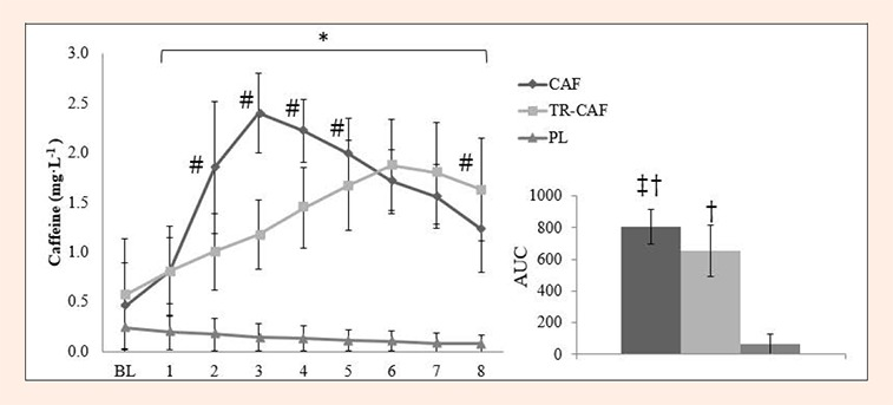
- Figure 17: Plasma caffeine concentration. PL = Placebo; TR-CAF = Extended Release Caffeine Supplement; CAF = Regular Caffeine Supplement; AUC = Area under the curve * Plasma caffeine concentration for CAF and TR-CAF was significantly higher than PL (p < 0.001). # Plasma caffeine concentration was significantly different between CAF and TR-CAF (p < 0.05). †CAF and TR-CAF showed a significantly higher plasma caffeine concentration AUC than PL over the 8 hours (p < 0.0001). ‡ CAF showed a significantly higher plasma caffeine concentration AUC than TR-CAF over the 8 hours (p = 0.001).
REFERENCES
- 2020-21 NCAA Banned Substances. https://www.ncaa.org/sport-science-institute/topics/2020-21-ncaa-banned-substances
- Abhijeet Morde;Kothapally Sudhakar;Maddela Rambabu;Alukapally Shankar;Deshanie Rai;Krishnaji Pawar;Manutosh Acharya;Munja Bakan;Pravin Nalawade;Ravindra Nayakwadi;Muralidhara Padigaru; (2021). Pharmacokinetic profile of a novel sustained-release caffeine with extended benefits on alertness and mood: A randomized, double-blind, single-dose, active-controlled, crossover study. Current Research in Behavioral Sciences, (), –. doi:10.1016/j.crbeha.2021.100036
- Astrup A. Thermogenic drugs as a strategy for treatment of obesity. Endocrine 2000;13:207–12.10.1385/ENDO:13:2:207
- Baviere HD, Liege UD, Luyckx A, Demey-ponsart E, Lee P. Effects of coffee and caffeine on carbohydrate metabolism, free fatty acid, insulin, growth hormone and cortisol plasma levels in man. Acta Diabet Lat 1973;6:1069–84.
- Bracco D, Ferrarra JM, Arnaud MJ, Jéquier E, Schutz Y. Effects of caffeine on energy metabolism, heart rate, and methylxanthine metabolism in lean and obese women. Am J Physiol 1995;269:E671–8.10.1152/ajpendo.1995.269.4.E671
- Caffeine & Health. By Jack E. James. Academic Press – Harcourt Brace Jovanovish, Publishers. New York, 1991.
- Carpene' MA, Testar Nova Science Publishers Inc. Chapter 8; 141–168.
- EFSA NDA Panel (EFSA Panel on Dietetic Products, Nutrition and Allergies), 2015. Scientific Opinion on the safety of caffeine. EFSAJournal 2015; 13(5):4102, 120 pp. doi:10.2903/j.efsa.2015.4102
- Gonzalez AM, Hoffman JR, Wells AJ, Mangine GT, Townsend JR, Jajtner AR, Wang R, Miramonti AA, Pruna GJ, LaMonica MB, Bohner JD, Hoffman MW, Oliveira LP, Fukuda DH, Fragala MS, Stout JR. Effects of time-release caffeine containing supplement on metabolic rate, glycerol concentration and performance. J Sports Sci Med. 2015 May 8;14(2):322-32. PMID: 25983581; PMCID: PMC4424461.
- Gutiérrez-Hellín J, Del Coso J. Acute p-synephrine ingestion increases fat oxidation rate during exercise. Br J Clin Pharmacol. 2016 Aug;82(2):362-8. doi: 10.1111/bcp.12952. Epub 2016 May 7. PMID: 27038225; PMCID: PMC4972152.
- Gutiérrez-Hellín J, Del Coso J. Dose-Response Effects of p-Synephrine on Fat Oxidation Rate During Exercise of Increasing Intensity. Phytother Res. 2018 Feb;32(2):370-374. doi: 10.1002/ptr.5937. Epub 2017 Oct 11. PMID: 29024325.
- Gutiérrez-Hellín J, Ruiz-Moreno C, Aguilar-Navarro M, Muñoz A, Varillas-Delgado D, Amaro-Gahete FJ, Roberts JD, Del Coso J. Placebo Effect of Caffeine on Substrate Oxidation during Exercise. Nutrients. 2021 Feb 27;13(3):782. doi:10.3390/nu13030782. PMID: 33673567; PMCID: PMC7997444.
- Hodgson, Adrian & Randell, Rebecca & Jeukendrup, Asker. (2013). The Effect of Green Tea Extract on Fat Oxidation at Rest and During Exercise: Evidence of Efficacy and Proposed Mechanisms. Advances in nutrition (Bethesda, Md.). 4. 129-140. 10.3945/an.112.003269.
- Hossein S, Javad S, Ajami M, Mohseni-Bandpei A. Caffeine treatment prevented from weight regain after calorie shifting diet induced weight loss. Iranian J Pharma Res 2014;13:707–18.
- https://asmalldoseoftoxicology.squarespace.com/s/Chapter-5-CaffeineED2042210-Spanish.pdf
- https://www.rivm.nl/node/92541
- https://www.wada-ama.org/en/prohibited-list ?
- Hursel R, Viechtbauer W, Dulloo AG, Tremblay A, Tappy L, Rumpler W, Westerterp-Plantenga MS. The effects of catechin rich teas and caffeine on energy expenditure and fat oxidation: a meta-analysis. Obes Rev. 2011 Jul;12(7):e573-81. doi: 10.1111/j.1467-789X.2011.00862.x. Epub 2011 Mar 2. PMID: 21366839.
- Institute of Medicine (US) Committee on Military Nutrition Research. Caffeine for the Sustainment of Mental Task Performance: Formulations for Military Operations. Washington (DC): National Academies Press (US); 2001. 2, Pharmacology of Caffeine. Available from: https://www.ncbi.nlm.nih.gov/books/NBK223808/
- Kamimori GH, Somani SM, Knowlton RG, Perkins RM. The effects of obesity and exercise on the pharmacokinetics of caffeine in lean and obese volunteers. Eur J Clin Pharmacol 1987;31:595–600.10.1007/BF00606637
- Kapoor MP, Sugita M, Fukuzawa Y, Okubo T. Physiological effects of epigallocatechin-3-gallate (EGCG) on energy expenditure for prospective fat oxidation in humans: A systematic review and meta-analysis. J Nutr Biochem. 2017 May;43:1-10. doi: 10.1016/j.jnutbio.2016.10.013. Epub 2016 Nov 2. PMID: 27883924.
- Leblanc J, Jobin M, Cote J, Samson P, Labrie A. Enhanced metabolic response to caffeine in exercise-trained human subjects. J Appl Physiol. 1985;59:832–7.10.1152/jappl.1985.59.3.832
- Ma G, Bavadekar SA, Schaneberg BT, Khan IA, Feller DR. Effects of synephrine and beta-phenethylamine on human alpha-adrenoceptor subtypes. Planta Med. 2010 Jul;76(10):981-6. doi:10.1055/s-0029-1240884
- Maki KC, Reeves MS, Farmer M, Yasunaga K, Matsuo N, Katsuragi Y, Komikado M, Tokimitsu I, Wilder D, Jones F, Blumberg JB, Cartwright Y. Green tea catechin consumption enhances exercise-induced abdominal fat loss in overweight and obese adults. J Nutr. 2009 Feb;139(2):264-70. doi: 10.3945/jn.108.098293. Epub 2008 Dec 11. PMID: 19074207.
- Mereles, D., & Hunstein, W. (2011). Epigallocatechin-3-gallate (EGCG) for clinical trials: more pitfalls than promises?. International journal of molecular sciences, 12(9), 5592–5603. https://doi.org/10.3390/ijms12095592
- Mielgo-Ayuso J, Barrenechea L, Alcorta P, Larrarte E, Margareto J, Labayen I. Effects of dietary supplementation with epigallocatechin-3-gallate on weight loss, energy homeostasis, cardiometabolic risk factors and liver function in obese women: randomized, double -blind, placebo-controlled clinical trial. Br J Nutr. 2014 Apr 14;111(7):1263-71. doi: 10.1017/S0007114513003784. Epub 2013 Dec 3. PMID: 24299662.
- Poehlman ET, Despres JP, Bessette H, Fontaine E, Tremblat A, Bouchard C. Influence of caffeine on the resting metabolic rate of exercise-trained and inactive subjects. Med Sci Sport Exerc 1985;17:689–94.10.1249/00005768-198512000-00012
- Rondanelli M, Riva A, Petrangolini G, Allegrini P, Perna S, Faliva MA, Peroni G, Naso M, Nichetti M, Perdoni F, Gasparri C. Effect of Acute and Chronic Dietary Supplementation with Green Tea Catechins on Resting Metabolic Rate, Energy Expenditure and Respiratory Quotient: A Systematic Review. Nutrients. 2021; 13(2):644. https://doi.org/10.3390/nu13020644
- Ruiz-Moreno C, Gutiérrez-Hellín J, Amaro-Gahete FJ, González-García J, Giráldez-Costas V, Pérez-García V, Del Coso J. Caffeine increases whole-body fat oxidation during 1 h of cycling at Fatmax. Eur J Nutr. 2021 Jun;60(4):2077-2085. doi:10.1007/s00394-020-02393-z. Epub 2020 Oct 6. PMID: 33025051.
- Ruiz-Moreno, C., Del Coso, J., Giráldez-Costas, V., González-García, J., & Gutiérrez-Hellín, J. (2021). Effects of p-Synephrine during Exercise: A Brief Narrative Review. Nutrients, 13(1), 233. https://doi.org/10.3390/nu13010233
- Schubert MM, Hall S, Leveritt M, Grant G, Sabapathy S, Desbrow B. Caffeine consumption around an exercise bout: effects on energy expenditure, energy intake, and exercise enjoyment. J Appl Physiol 2014;117:745–54.10.1152/japplphysiol.00570.2014
- Stohs SJ, Shara M. Review of the safety and efficacy of bitter orange (Citrus aurantium) and its primary protoalkaloid, p-synephrine, in weight management. In: Bagchi D., Preuss HG, editors. Obesity: Epidemiology, Pathophysiology, and Prevention. 2nd ed. CRC Press; Boca Raton, FL, USA: 2007. pp. 535–554.
- Tabrizi R, Saneei P, Lankarani KB, Akbari M, Kolahdooz F, Esmaillzadeh A, Nadi-Ravandi S, Mazoochi M, Asemi Z. The effects of caffeine intake on weight loss: a systematic review and two-response meta-analysis of randomized controlled trials. Crit Rev Food Sci Nutr. 2019;59(16):2688-2696. doi: 10.1080/10408398.2018.1507996. Epub 2018 Oct 18. PMID: 30335479.
- The World of Caffeine – The Science and Culture of the World's Most Popular Drug. By: Bennett Alan Weinberg and Bonnie K. Bealer. Routledge, New York and London 2001.
- Thevis M, Koch A, Sigmund G, Thomas A, Schänzer W. Analysis of octopamine in human doping control samples. Biomed Chromatogr. 2012 May;26(5):610-5. doi:10.1002/bmc.1705. Epub 2011 Sep 19. PMID: 21932383.
- Venables MC, Hulston CJ, Cox HR, Jeukendrup AE. Green tea extract ingestion, fat oxidation, and glucose tolerance in healthy humans. Am J Clin Nutr. 2008 Mar;87(3):778-84. doi: 10.1093/ajcn/87.3.778. PMID: 18326618.
- Westerterp-Plantenga M. Physiology & behavior green tea catechins, caffeine and body-weight regulation. Physiol Behav 2010; 100:42–6.10.1016/j.physbeh.2010.02.005




![Mc MANI [500g]](http://bigsupps.site/cdn/shop/products/producto_McMani_500g_toasted_0noflavor_500x600_d4cadf06-096b-4ad3-8d36-4ed77e23d36d_200x.png?v=1603196512)
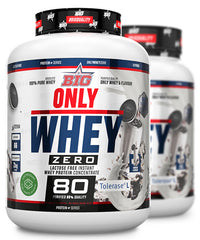
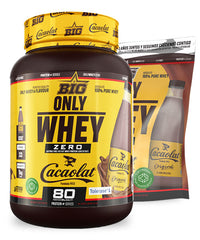
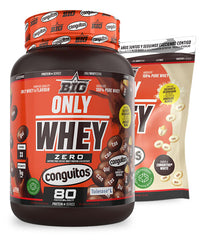

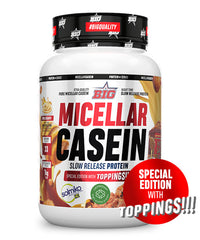
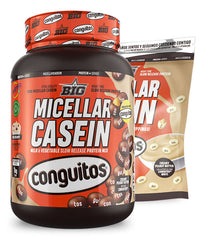
![CFM ISO ZERO [saco]](http://bigsupps.site/cdn/shop/files/producto_cfm_doypack_0noflavour_500x600a_200x.jpg?v=1750981452)
![CLEAR ISO ZERO [750g]](http://bigsupps.site/cdn/shop/files/producto_BIG_clearprotein_icepop_0noflavour_500x600a_200x.jpg?v=1757074297)
![CREABIG FIESTA® KOJAK® flavor - [250g]](http://bigsupps.site/cdn/shop/files/producto_BIG_creabig_kojak_0noflavour_500x600a_200x.jpg?v=1763548822)
